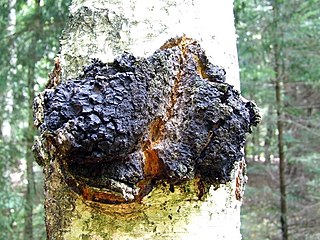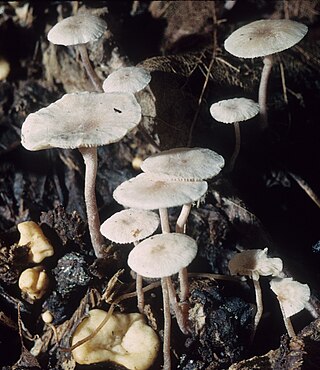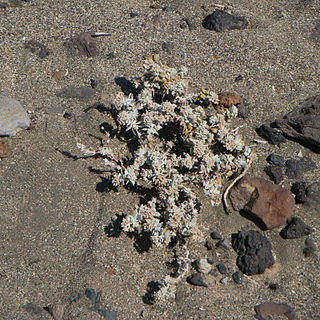
The Hymenochaetales are an order of fungi in the class Agaricomycetes. The order in its current sense is based on molecular research and not on any unifying morphological characteristics. According to one 2008 estimate, the Hymenochaetales contain around 600 species worldwide, mostly corticioid fungi and poroid fungi, but also including several clavarioid fungi and agarics. Species of economic importance include wood decay fungi in the genera Phellinus and Inonotus sensu lato, some of which may cause losses in forestry. Therapeutic properties are claimed for Inonotus obliquus ("chaga") and Phellinus linteus, both of which are now commercially marketed.

Inonotus obliquus, commonly called chaga, is a fungus in the family Hymenochaetaceae. It is parasitic on birch and other trees. The sterile conk is irregularly formed and resembles burnt charcoal. It is not the fruiting body of the fungus, but a sclerotium or mass of mycelium, mostly black because of a great amount of melanin. Some people consider chaga medicinal.
Moroccan rap music is a Moroccan musical style related to rap and hip hop culture.

Inonotus cuticularis is a species of fungus in the family Hymenochaetaceae. A plant pathogen, it has a circumpolar distribution, and is found in the temperate zone from eastern U.S. and Canada to Japan, China, Russia and south to central Europe.
Conqueyrac is a commune in the Gard department in southern France.

Altica is a large genus of flea beetles in the subfamily Galerucinae, with about 300 species, distributed nearly worldwide. The genus is best represented in the Neotropical realm, well represented in the Nearctic and Palearctic, but occurs also in the Afrotropic, Indomalaya, and Australasia. The species are similar to each other, small metallic blue-green-bronze beetles, often distinguished from each other only by the aedeagus. The species of Altica, both as larvae and as adults, are phytophagous, feeding on plant foliage of various food plant taxa, specific for each Altica species. Onagraceae and Rosaceae are the dominant host plant families for Holarctic species. The adult Altica beetles are able to jump away when approached.

Inonotus is a genus of fungi in the family Hymenochaetaceae. The genus, described by Petter Karsten in 1879, is estimated to contain about 80 species sensu lato and 30 species sensu stricto.
Dorcatoma serra is a species of beetle in the family Ptinidae from Europe. It is often considered to be a synonym of Dorcatoma substriata.
Agdistis tamaricis is a moth of the family Pterophoridae found in Africa, Asia and Europe. It was first described by the German entomologist, Philipp Christoph Zeller in 1847.

Collybia cookei is a species of fungus in the family Tricholomataceae, and one of three species in the genus Collybia. It is known from Europe, Asia, and North America. The fungus produces fruit bodies that usually grow on the decomposing remains of other mushrooms, like Meripilus giganteus, Inonotus hispidus, or species of Russula; occasionally fruit bodies are found on rich humus or well-decayed wood. The fungus produces small white mushrooms with caps up to 9 mm (0.35 in) in diameter, supported by thin stems that originate from a yellowish-brown sclerotium. The mushroom is difficult to distinguish from the other two species of Collybia unless an effort is made to examine the sclerotia, which is usually buried in the substrate. The edibility of the mushroom has not been determined.
Altica tamaricis is a species of flea beetle from the family of leaf beetles, that can be found in Europe.
Altica tamaricis is a species of flea beetle from the family of leaf beetles that can be found everywhere in Europe and Near East.

Iris filifolia is a species in the genus Iris, it is also in the subgenus Xiphium. It is a bulbous perennial from North Africa and Europe. It has thin leaves, summer flowers in shades of red-purple.
Georges Jean Louis Malençon was a French mycologist known for his investigations of fungi native to North Africa and the Iberian Peninsula.
Inonotus chrysomarginatus is a species of fungus in the family Hymenochaetaceae. It is distinguished by having an annual to perennial growth habit, pileate basidiocarps, setal hyphae and hooked hymenial setae, and subglobose, yellowish, thick-walled cyanophilous basidiospores.
Inonotus acutus is a species of fungus in the family Hymenochaetaceae. It is characterized by having small and thin basidiocarps, a sharp pileus margin, ventricose hymenial setae, and ellipsoid, yellowish and thick-walled basidiospores.

Inocutis is a genus of nine species of polypore fungi in the family Hymenochaetaceae.

Polycarpaea nivea is a species of flowering plants in the family Caryophyllaceae. The species was described by William Aiton in 1828 as Achyranthes nivea, and it was placed in the genus Polycarpaea by Philip Barker Webb in 1849. The specific name nivea is Latin for "white as snow", and refers to the colour of the plant.
Magnimus is a genus of extinct mammal from the Early Cretaceous of Southern England. The type and only species is Magnimus ensomi, described in 1999 by Denise Sigogneau-Russell for molars from the Berriasian Lulworth Formation. The specific name was given to honour Paul Ensom, a discoverer of many teeth from the Purbeck beds, while the generic name is from the Latin words for "large" and "mouse". It is similar to but distinct from Peramus and Abelodon, but its classification cannot be narrowed down beyond indeterminate Zatheria due to its incomplete nature.
Jean Gattefossé was a French chemist, botanist, journalist and industrialist.








